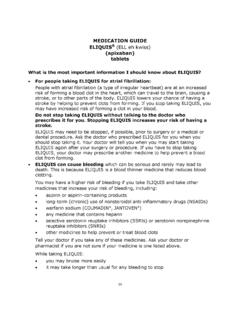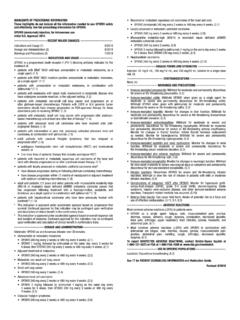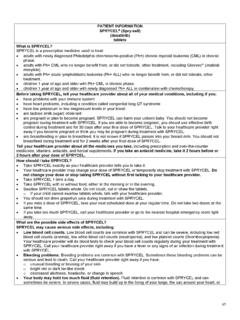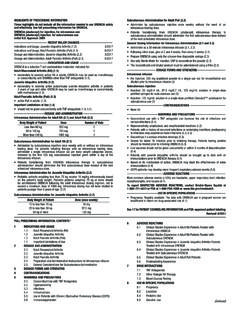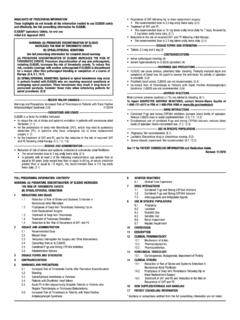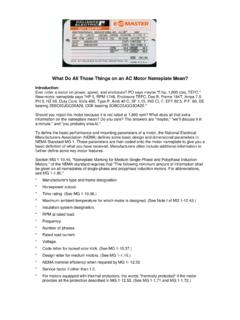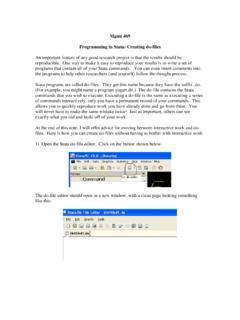Transcription of HIGHLIGHTS OF PRESCRIBING INFORMATION These …
1 HIGHLIGHTS OF PRESCRIBING INFORMATION Adolescents (ages 14 to 18 years): the recommended starting dose is 40 mg These HIGHLIGHTS do not include all the INFORMATION needed to use once daily. ( ). pravachol safely and effectively. See full PRESCRIBING INFORMATION for ---------------------------DOSAGE FORMS AND STRENGTHS-------------------- pravachol . Tablets: 20 mg, 40 mg, 80 mg. (3). pravachol (pravastatin sodium) Tablets --------------------------------CONTRAIN DICATIONS------------------------------- - Initial Approval: 1991 Hypersensitivity to any component of this medication. ( , , 11). ----------------------------RECENT MAJOR CHANGES--------------------------- Active liver disease or unexplained, persistent elevations of serum Dosage and Administration transaminases. ( , ). Patients with Renal Impairment ( ) 7/2016 Pregnancy ( , , ).
2 Contraindications Lactation ( , ). Pregnancy ( ), Lactation ( ) 7/2016 ----------------------------WARNINGS AND PRECAUTIONS----------------------- -----------------------------INDICATIONS AND USAGE------------------------------ Skeletal muscle effects ( , myopathy and rhabdomyolysis): predisposing pravachol is an HMG-CoA reductase inhibitor (statin) indicated as an factors include advanced age ( 65), uncontrolled hypothyroidism, and renal adjunctive therapy to diet to: impairment. Patients should be advised to promptly report to their physician Reduce the risk of MI, revascularization, and cardiovascular mortality in any unexplained and/or persistent muscle pain, tenderness, or weakness. hypercholesterolemic patients without clinically evident CHD. ( ) Pravastatin therapy should be discontinued if myopathy is diagnosed or Reduce the risk of total mortality by reducing coronary death, MI, suspected.
3 ( , ). revascularization, stroke/TIA, and the progression of coronary atherosclerosis Liver enzyme abnormalities: persistent elevations in hepatic transaminases in patients with clinically evident CHD. ( ) can occur. Check liver enzyme tests before initiating therapy and as clinically Reduce elevated Total-C, LDL-C, ApoB, and TG levels and to increase HDL- indicated thereafter. ( ). C in patients with primary hypercholesterolemia and mixed dyslipidemia. -----------------------------------ADVER SE REACTIONS------------------------------ ( ) In short-term clinical trials, the most commonly reported adverse reactions ( 2%. Reduce elevated serum TG levels in patients with hypertriglyceridemia. ( ) and > placebo) regardless of causality were: musculoskeletal pain, Treat patients with primary dysbetalipoproteinemia who are not responding to nausea/vomiting, upper respiratory infection, diarrhea, and headache.
4 ( ). diet. ( ) To report SUSPECTED ADVERSE REACTIONS, contact Bristol-Myers Treat children and adolescent patients ages 8 years and older with Squibb at 1-800-721-5072 or FDA at 1-800-FDA-1088 or heterozygous familial hypercholesterolemia after failing an adequate trial of diet therapy. ( ) ------------------------------------DRUG INTERACTIONS---------------------------- - Limitations of use: Concomitant lipid-lowering therapies: use with fibrates or lipid-modifying pravachol has not been studied in Fredrickson Types I and V doses ( 1 g/day) of niacin increases the risk of adverse skeletal muscle dyslipidemias. ( ) effects. Caution should be used when PRESCRIBING with pravachol . (7). -----------------------------DOSAGE AND ADMINISTRATION-------------------- Cyclosporine: combination increases exposure.
5 Limit pravastatin to 20 mg Adults: the recommended starting dose is 40 mg once daily. Use 80 mg dose once daily. ( , ). only for patients not reaching LDL-C goal with 40 mg. ( ) Clarithromycin: combination increases exposure. Limit pravastatin to 40 mg Significant renal impairment: the recommended starting dose is pravastatin 10 once daily. ( , ). mg once daily. ( ) See 17 for PATIENT COUNSELING INFORMATION . Children (ages 8 to 13 years, inclusive): the recommended starting dose is 20 mg once daily. ( ). Revised: 7/2016. FULL PRESCRIBING INFORMATION : CONTENTS*. 1 INDICATIONS AND USAGE Niacin Prevention of Cardiovascular Disease 8 USE IN SPECIFIC POPULATIONS. Hyperlipidemia Pregnancy Limitations of Use Lactation 2 DOSAGE AND ADMINISTRATION Females and Males of Reproductive Potential General Dosing INFORMATION Pediatric Use Adult Patients Geriatric Use Patients with Renal Impairment Homozygous Familial Hypercholesterolemia Pediatric Patients 10 OVERDOSAGE.
6 Concomitant Lipid-Altering Therapy 11 DESCRIPTION. Dosage in Patients Taking Cyclosporine 12 CLINICAL PHARMACOLOGY. Dosage in Patients Taking Clarithromycin Mechanism of Action 3 DOSAGE FORMS AND STRENGTHS Pharmacokinetics 4 CONTRAINDICATIONS 13 NONCLINICAL TOXICOLOGY. Hypersensitivity Carcinogenesis, Mutagenesis, Impairment of Fertility Liver Animal Toxicology and/or Pharmacology Pregnancy 14 CLINICAL STUDIES. Lactation Prevention of Coronary Heart Disease 5 WARNINGS AND PRECAUTIONS Secondary Prevention of Cardiovascular Events Skeletal Muscle Primary Hypercholesterolemia (Fredrickson Types IIa and Liver IIb). Endocrine Function Hypertriglyceridemia (Fredrickson Type IV). 6 ADVERSE REACTIONS Dysbetalipoproteinemia (Fredrickson Type III). Adverse Clinical Events Pediatric Clinical Study Postmarketing Experience 15 REFERENCES.
7 Laboratory Test Abnormalities 16 HOW SUPPLIED/STORAGE AND HANDLING. Pediatric Patients How Supplied 7 DRUG INTERACTIONS Storage Cyclosporine 17 PATIENT COUNSELING INFORMATION . Clarithromycin and Other Macrolide Antibiotics Colchicine * Sections or subsections omitted from the full PRESCRIBING INFORMATION Gemfibrozil are not listed. Other Fibrates 1. FULL PRESCRIBING INFORMATION . 1 INDICATIONS AND USAGE. Therapy with lipid-altering agents should be only one component of multiple risk factor intervention in individuals at significantly increased risk for atherosclerotic vascular disease due to hypercholesterolemia. Drug therapy is indicated as an adjunct to diet when the response to a diet restricted in saturated fat and cholesterol and other nonpharmacologic measures alone has been inadequate.
8 Prevention of Cardiovascular Disease In hypercholesterolemic patients without clinically evident coronary heart disease (CHD), pravachol (pravastatin sodium) is indicated to: reduce the risk of myocardial infarction (MI). reduce the risk of undergoing myocardial revascularization procedures. reduce the risk of cardiovascular mortality with no increase in death from non-cardiovascular causes. In patients with clinically evident CHD, pravachol is indicated to: reduce the risk of total mortality by reducing coronary death. reduce the risk of MI. reduce the risk of undergoing myocardial revascularization procedures. reduce the risk of stroke and stroke/transient ischemic attack (TIA). slow the progression of coronary atherosclerosis. Hyperlipidemia pravachol is indicated: as an adjunct to diet to reduce elevated total cholesterol (Total-C), low-density lipoprotein cholesterol (LDL-C), apolipoprotein B (ApoB), and triglyceride (TG) levels and to increase high-density lipoprotein cholesterol (HDL-C) in patients with primary hypercholesterolemia and mixed dyslipidemia (Fredrickson Types IIa and IIb).
9 1. as an adjunct to diet for the treatment of patients with elevated serum TG levels (Fredrickson Type IV). for the treatment of patients with primary dysbetalipoproteinemia (Fredrickson Type III). who do not respond adequately to diet. 2. as an adjunct to diet and lifestyle modification for treatment of heterozygous familial hypercholesterolemia (HeFH) in children and adolescent patients ages 8 years and older if after an adequate trial of diet the following findings are present: a. LDL-C remains 190 mg/dL or b. LDL-C remains 160 mg/dL and: there is a positive family history of premature cardiovascular disease (CVD) or two or more other CVD risk factors are present in the patient. Limitations of Use pravachol has not been studied in conditions where the major lipoprotein abnormality is elevation of chylomicrons (Fredrickson Types I and V).
10 2 DOSAGE AND ADMINISTRATION. General Dosing INFORMATION The patient should be placed on a standard cholesterol-lowering diet before receiving pravachol and should continue on this diet during treatment with pravachol [see NCEP Treatment Guidelines for details on dietary therapy]. Adult Patients The recommended starting dose is 40 mg once daily. If a daily dose of 40 mg does not achieve desired cholesterol levels, 80 mg once daily is recommended. pravachol can be administered orally as a single dose at any time of the day, with or without food. Since the maximal effect of a given dose is seen within 4 weeks, periodic lipid determinations should be performed at this time and dosage adjusted according to the patient's response to therapy and established treatment guidelines. Patients with Renal Impairment In patients with severe renal impairment, a starting dose of 10 mg pravastatin daily is recommended.
